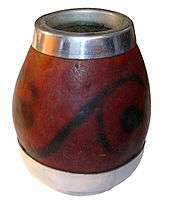Gourd



A gourd is a plant of the family Cucurbitaceae, particularly Cucurbita and Lagenaria or the fruit of the two genera of Bignoniaceae "calabash tree", Crescentia and Amphitecna.
The term refers to a number of species and subspecies, many with hard shells, and some without. Likely one of the earliest domesticated types of plants, subspecies of the bottle gourd, Lagenaria siceraria, have been discovered in archaeological sites dating from as early as 13,000 BC. Gourds have had numerous uses throughout history, including as tools, musical instruments, objects of art, film, and food.
Terminology
Gourd is occasionally used to describe crop plants in the family Cucurbitaceae, like pumpkins, cucumbers, squash, luffa, and melons.[1] More specifically, gourd refers to the fruits of plants in the two Cucurbitaceae genera Lagenaria and Cucurbita,[2][3] or also to their hollow, dried-out shell. A gourd can also have a hard shell when dehydrated.
There are many different gourds worldwide. The main plants referred to as gourds include several species from the Cucurbita genus (mostly native to North America, including the Malabar gourd and turban squash), Crescentia cujete (the tree gourd or calabash tree, native to the American tropics) and Lagenaria siceraria (bottle gourd).[4][5] Other plants with gourd in their name include the luffa gourd (likely domesticated in Asia), which includes several species from the Luffa genus, as well as the wax gourd, snake gourd, teasel gourd, hedgehog gourd, buffalo gourd/coyote gourd. The bitter melon/balsam apple/balsam pear is also sometimes referred to as a gourd.[5][6]
History
L. siceraria was brought to Europe and the Americas very early in history, being found in Peruvian archaeological sites dating from 13,000 to 11,000 BC and Thailand sites from 11,000 to 6,000 BC.[4] A study of bottle gourd DNA published in 2005 suggests that there are two distinct subspecies of bottle gourds, domesticated independently in Africa and Asia, the latter approximately 4,000 years earlier. The gourds found in the Americas appear to have come from the Asian subspecies, very early in history; a new study now indicates Africa.[7] The archaeological and DNA records show it likely that the gourd was among the first domesticated species, in Asia between 12,000 and 13,000 BP, and possibly the first domesticated plant species.[8]
Gourds continued to be used throughout history, in almost every culture throughout the world. European contact in North America found extensive gourd use, including the use of bottle gourds as birdhouses to attract purple martins, which provided bug control for agriculture. Almost every culture had musical instruments made of gourds, including drums, stringed instruments common to Africa and wind instruments, including the nose flutes of the Pacific.[9]
20th century to present
Scientists in India have been working on crossbreeding six members of the bitter gourd genus found in the country to reduce the unpleasant taste while retaining the nutritional and medicinal values of the plants. These include Teasle gourd (Momordica Dioica), Spine gourd (Momordica subangulata), Sweet gourd (Momordica cochinchinensis), balsam apple (Momordica balsamina) and Momordica sahyadrica.[10]
Uses

Cultures from arid regions often associated gourds with water, and they appear in many creation myths. Since the beginning of their history, they have had a multitude of uses, including food, kitchen tools, toys, musical instruments and decoration.[4] Today, gourds are commonly used for a wide variety of crafts, including jewelry, furniture, dishes, utensils and a wide variety of decorations using carving, burning and other techniques.[11]
The Chinese developed a technique of tying a two-part mould around young gourds, or a part of them, so that the gourd grew into the mould and took its shape. Shaped gourds had various decorative uses, especially as boxes, bottles and other containers.
The Luffa gourds, Luffa aegyptiaca and Luffa acutangula, have been used throughout recent history as scrubbing sponge and strainer. This is prepared by removing the skin and pulp from the gourd, and bleaching the fibers.
See also
- Maracas are percussion instruments often made from gourds
Footnotes
- ↑ "Cucurbitaceae". Retrieved 24 October 2011.
- ↑ Paris, H. S. (1989). Historical records, origins, and development of the edible cultivar groups of Cucurbita pepo (Cucurbitaceae). Economic Botany, 43(4), 423-443.
- ↑ Cutler, Whitaker. 1961. History and distribution of the cultivated cucurbits in the Americas.
- 1 2 3 Ghillean Prance; Mark Nesbitt, eds. (2012). The Cultural History of Plants. Routledge. pp. 21 & 348. ISBN 1135958106.
- 1 2 Summit, p. 21
- ↑ Ginger Summit (2001). Gourds in Your Garden: A Guidebook for the Home Gardener. Sterling Publishing Company. pp. 18–19. ISBN 0806926996.
- ↑ "Scientists solve mystery of World travelling plant", Science, Feb 2014.
- ↑ Erickson, David L.; Smith, Bruce D.; Clarke, Andrew C.; Sandweiss, Daniel H.; Tuross, Noreen (2005). "An Asian origin for a 10,000-year-old domesticated plant in the Americas". PNAS. 102 (51): 18315–18320. Bibcode:2005PNAS..10218315E. doi:10.1073/pnas.0509279102. PMC 1311910
 . PMID 16352716.
. PMID 16352716. - ↑ Summit, p. 23
- ↑ "Bitter gets better". Down To Earth. 2012-09-30. Retrieved 2012-12-21.
- ↑ Mickey Baskett (2005). Glorious Gourd Decorating. Sterling Publishing Company, Inc. p. 9. ISBN 1402727755.
External links
| Wikimedia Commons has media related to Gourds. |
 "Gourd". Encyclopædia Britannica (11th ed.). 1911.
"Gourd". Encyclopædia Britannica (11th ed.). 1911.
_with_Flower_Vases_and_Inscriptions_LACMA_M.45.3.333a-b.jpg)